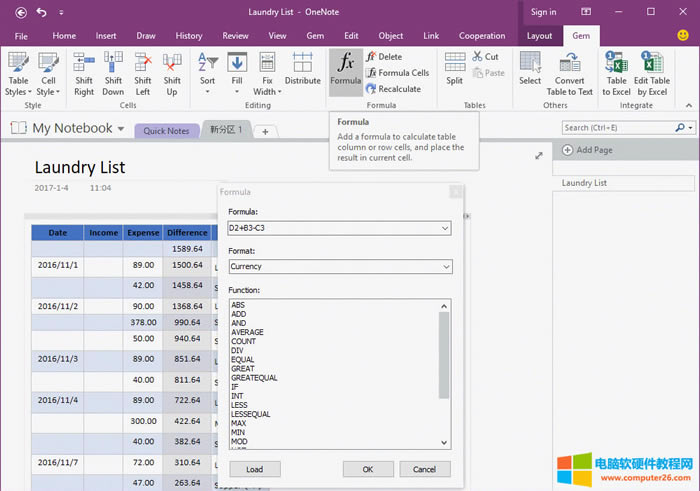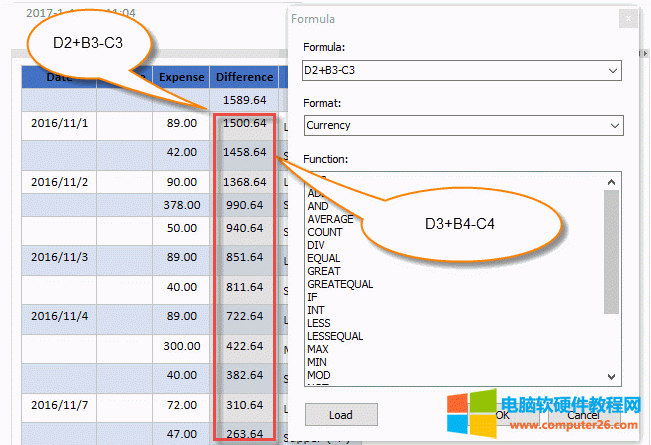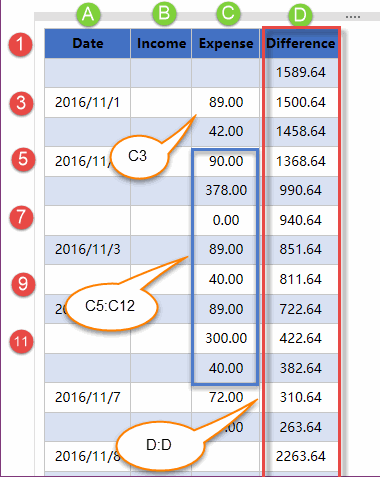| 辦公軟件是指可以進行文字處理、表格制作、幻燈片制作、圖形圖像處理、簡單數據庫的處理等方面工作的軟件。目前辦公軟件朝著操作簡單化,功能細化等方向發展。辦公軟件的應用范圍很廣,大到社會統計,小到會議記錄,數字化的辦公,離不開辦公軟件的鼎力協助。另外,政府用的電子政務,稅務用的稅務系統,企業用的協同辦公軟件,這些都屬于辦公軟件。 OneNote 表格公式是 Gem for OneNote 的一組功能。這組功能為 OneNote 的表格添加類似 Excel 的公式,用于計算統計單元格。
如何找到 OneNote 表格公式
OneNote 表格公式隱藏在第二個“珍”選項卡中。當你在 OneNote里選中表格時,該選項卡才會出來。
首先,在 OneNote 當前頁面里,創建或者選中一個表格。這是 OneNote 功能區會多出一個“表格工具”的隱藏選項卡集合,這個選項卡集合顯示有 2 個選項卡“布局”和“珍”選項卡。
其中“珍”選項卡則是 Gem for OneNote 的選項卡,專門用于針對表格的處理功能。表格公式就在這個組里。
在單元格里插入公式
首先,你可以選中一個或者選中一組單元格。然后在點擊“表格公式”功能。則會彈出一個“Formula”的對話框。
在 Formula 公式對話框里:
- 在 Formula:輸入框,輸入你的公式
- 在 Format:輸入框里,輸入格式。用于對公式計算的結果,按一定的格式顯示到單元格里。
- Function 列表里,則是列出 Gem 表格公式支持的函數。
點擊“OK”按鈕,則會把公式放到這個單元格里,并顯示格式化的計算結果。
如果選中的是多個單元格,則 Gem 會應用這個公式到所有選中的單元格,同時會自動調整公式里的單元格地址,以相對性的進行計算。
比如:對 單元格 D3 到 D14 進行批量應用公式 D2+B3-C3
則應用公式后的結果是:
- 單元格 D3 得到的公式是 D2+B3-C3
- 單元格 D4 得到的公式是 D3+B4-C4
- 單元格 D5 得到的公式是 D4+B5-C5
- ……
?修改單元格里的公式
如果想修改單元格里已經存在的公式,則先選中這個單元格,或者選中這組單元格,再點擊一次“表格公式”。還在彈出的 Formula 對話框里進行公式修改。
刪除單元格公式
如果想刪除單元格里的公式,可以先選中這個單元格(或者選中這組單元格),再點擊功能區上的“公式”組里“刪除”就可以把公式從這些單元格里移除掉了。
高亮存在公式的單元格
如果想知道哪里單元格包含公式,則可以點擊功能區上的”公式”組里的“含公式格”,則會選中表格里所有包含公式的單元格。
重新計算單元格數值
在表格里修改完部分數值后,表格公式并不會自動計算數值,你需要到功能區里“公式”組,點擊“重新計算”功能,來讓表格里的公式重新計算。
單元格地址、單元格區域
單元格地址使用 A1 的格式指定一個單元格、一組單元格或一個單元格區域。
在此約定中,字母表示單元格所在的列,數字表示單元格所在的行。
表格中的第一列為列 A;第一行為行 1。
第一列第二行中的單元格
A2
第一行中的前兩個單元格
A1,B1
第一列中的所有單元格以及第二列中的前兩個單元格
A1:B2
第一行
1:1
第一列
A:A
?算數操作符
算數操作符包括:+,-,*(乘),/
例子 1:
單元格 D2 加上 單元格 B3 減去 單元格 C3
D2+B3-C3
其他例子:
- If( (D2+B3-C3)>(D3+B4-C4), (D2+B3-C3), (D3+B4-C4) )
- SUM(A:A) * SUM(B:B)
關系操作符
關系操作符包括: <, >, <=, >=, =
關系操作符的使用:
- If( D3>D4, D3, D4)
- AND(SUM(LEFT)<10,SUM(ABOVE)>=5)
顯示格式
Date
以日期 2020-01-15 的格式顯示值。
Time
以時間 09:12:13 的格式顯示值。
DateTime
以日期時間 2020-01-15 09:12:13 的格式顯示值。
Date: yyyy/mm/dd hh:nn:ss
以自定義的日期時間格式顯示值。
| Specifier |
Displays |
| c |
Displays the date using the format given by the ShortDateFormat global variable, followed by the time using the format given by the LongTimeFormat global variable. The time is not displayed if the date-time value indicates midnight precisely. |
| d |
Displays the day as a number without a leading zero (1-31). |
| dd |
Displays the day as a number with a leading zero (01-31). |
| ddd |
Displays the day as an abbreviation (Sun-Sat) using the strings given by the ShortDayNames global variable. |
| dddd |
Displays the day as a full name (Sunday-Saturday) using the strings given by the LongDayNames global variable. |
| ddddd |
Displays the date using the format given by the ShortDateFormat global variable. |
| dddddd |
Displays the date using the format given by the LongDateFormat global variable. |
| e |
(Windows only) Displays the year in the current period/era as a number without a leading zero (Japanese, Korean, and Taiwanese locales only). |
| ee |
(Windows only) Displays the year in the current period/era as a number with a leading zero (Japanese, Korean, and Taiwanese locales only). |
| g |
(Windows only) Displays the period/era as an abbreviation (Japanese and Taiwanese locales only). |
| gg |
(Windows only) Displays the period/era as a full name (Japanese and Taiwanese locales only). |
| m |
Displays the month as a number without a leading zero (1-12). If the m specifier immediately follows an h or hh specifier, the minute rather than the month is displayed. |
| mm |
Displays the month as a number with a leading zero (01-12). If the mm specifier immediately follows an h or hh specifier, the minute rather than the month is displayed. |
| mmm |
Displays the month as an abbreviation (Jan-Dec) using the strings given by the ShortMonthNames global variable. |
| mmmm |
Displays the month as a full name (January-December) using the strings given by the LongMonthNames global variable. |
| yy |
Displays the year as a two-digit number (00-99). |
| yyyy |
Displays the year as a four-digit number (0000-9999). |
| h |
Displays the hour without a leading zero (0-23). |
| hh |
Displays the hour with a leading zero (00-23). |
| n |
Displays the minute without a leading zero (0-59). |
| nn |
Displays the minute with a leading zero (00-59). |
| s |
Displays the second without a leading zero (0-59). |
| ss |
Displays the second with a leading zero (00-59). |
| z |
Displays the millisecond without a leading zero (0-999). |
| zzz |
Displays the millisecond with a leading zero (000-999). |
| t |
Displays the time using the format given by the ShortTimeFormat global variable. |
| tt |
Displays the time using the format given by the LongTimeFormat global variable. |
| am/pm |
Uses the 12-hour clock for the preceding h or hh specifier, and displays 'am' for any hour before noon, and 'pm' for any hour after noon. The am/pm specifier can use lower, upper, or mixed case, and the result is displayed accordingly. |
| a/p |
Uses the 12-hour clock for the preceding h or hh specifier, and displays 'a' for any hour before noon, and 'p' for any hour after noon. The a/p specifier can use lower, upper, or mixed case, and the result is displayed accordingly. |
| ampm |
Uses the 12-hour clock for the preceding h or hh specifier, and displays the contents of the TimeAMString global variable for any hour before noon, and the contents of the TimePMString global variable for any hour after noon. |
| / |
Displays the date separator character given by the DateSeparator global variable. |
| : |
Displays the time separator character given by the TimeSeparator global variable. |
?支持的函數
Expr 表示子公式表達式。
ABS(Expr)
求絕對值。
示例:ABS(C3-(D2+B3)) 結果:1500.64
AND(Expr, Expr, ….)
計算括號中的所有參數是否均為 1 或者 0
示例:AND( (C4-C3)<0, (C6-C5)>0) 結果:1
AVERAGE(Expr, Expr, …)
計算平均值
示例:AVERAGE(C3,C4,C5) 結果:73.67
COUNT(Expr)
計算括號中指定的項目的個數。
示例:COUNT(BELOW) 結果:公式單元格下方(同一列中)的單元格個數。
IF( ConditionExpr, TrueExpr, FalseExpr)
如果第一個參數 ConditionExpr > 0,則返回第二個參數 TrueExpr
如果第一個參數 ConditionExpr = 0,,則返回第三個參數 FalseExpr
示例:IF(C3>10, 100, -100) 結果:100
INT(Expr)
獲取整數部分值。
示例:INT(D2+B3-C3) 結果:1500
MAX(Expr, Expr, …)
計算參數中的最大值。
示例:MAX(C3, C4, C5) 結果:90
MIN(Expr, Expr, …)
計算參數中的最小值。
示例:MIN(C3, C4, C5) 結果:42
MOD(Expr1, Expr2)
計算 Expr2 除以 Expr1 的余數。
示例:MOD(4, 2) 結果:0
NOT(Expr)
計算該參數 Expr = 1。
如果 Expr = 1,則返回 0;
如果 Expr = 0,則返回 1。
示例:NOT(C3=0) 結果:1
OR(Expr1, Expr2)
Expr1, Expr2 中有任何一個為非 0, 則返回 1, 否則返回 0。
示例:OR(C3<100, C4>40) 結果:1
ROUND(Expr1, Integer)
第二個參數 Integer 必須為整數或計算為整數。
將第一個參數 Expr 舍入到 Integer 指定的位數。
如果 Integer > 0,則將 Expr 向下舍入到指定的位數。
如果 Integer = 0,則將 Expr向下舍入到最近的整數。
如果 Integer < 0,則將 Expr向下舍入到小數點左側。
ROUND(123.456, 2) 結果:123.46
ROUND(123.456, 0) 結果:123
ROUND(123.456, -2) 結果:100
SIGN( Expr )
計算 Expr 是大于、等于還是小于零 (0)。
如果大于零,則返回 1;
如果等于零,則返回 0;
如果小于零,則返回 -1。
示例:SIGN(-11) 結果:-1
SUM( Expr, Expr, … )
求和
例子:
SUM(LEFT)
SUM(LEFT,ABOVE,RIGHT,BELOW)
SUM(C:C)
SUM(C1:C100)
Now
| 公式 |
說明 |
結果 |
| NOW() |
返回當前日期和時間。 |
2011-11-6 19:30 |
| NOW()-0.5 |
返回 12 小時前的日期和時間(-0.5 天前)。 |
2011-11-6 7:30 |
| NOW()+7 |
返回 7 天后的日期和時間。 |
2011-11-13 19:30 |
| NOW()-2.25 |
返回 2 天 6 小時前的日期和時間(-2.25 天前)。 |
2011-11-4 13:30 |
Date
合成日期
Date(Year, Month, Day)
Time
合成時間
Time(Hour, Minute, second)
Year
| 數據 |
|
|
| 日期 |
|
|
| 2008-7-5 |
|
|
| 2010-7-5 |
|
|
| 公式 |
描述(結果) |
結果 |
| =YEAR(A3) |
單元格 A3 中日期的年份 (2008) |
2008 |
| =YEAR(A4) |
單元格 A4 中日期的年份 (2010) |
2010 |
Month
| 日期 |
|
|
| 2011-4-15 |
|
|
| 公式 |
說明 |
結果 |
| MONTH(A2) |
單元格 A2 中日期的月份 |
4 |
Day
| 日期 |
|
|
| 2011-4-15 |
|
|
| 公式 |
描述(結果) |
結果 |
| DAY(A2) |
單元格 A2 (15) 中日期的天數 |
15 |
Hour
| 時間 |
|
|
| 0.75 |
|
|
| 2011-7-18 7:45 |
|
|
| 2012-4-21 |
|
|
| 公式 |
說明 |
結果 |
| HOUR(A2) |
返回 24 小時的 75% |
18 |
| HOUR(A3) |
返回日期/時間值的小時部分。 |
7 |
| HOUR(A4) |
未指定時間部分的日期被視作上午 12:00 或 0 小時。 |
0 |
Minute
| 時間 |
|
|
| 下午 12:45:00 |
|
|
| 公式 |
說明 |
結果 |
| MINUTE(A2) |
返回 A2 中時間值的分鐘部分。 |
45 |
Second
| 數據 |
|
|
| 時間 |
|
|
| 下午 4:48:18 |
|
|
| 下午 4:48 |
|
|
| 公式 |
說明 |
結 果 |
| SECOND(A3) |
第一個時間的秒數 (18) |
18 |
| SECOND(A4) |
第二個時間的秒數 (0) |
0 |
Office辦公軟件是辦公的第一選擇,這個地球人都知道。
|




